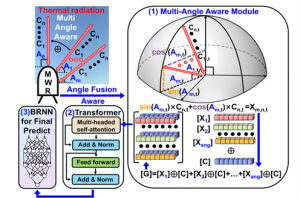AngleNet: a game-changer in atmospheric humidity retrieval
GA, UNITED STATES, October 6, 2025 /EINPresswire.com/ -- A new deep-learning model, AngleNet, significantly improves the retrieval accuracy of atmospheric relative humidity (RH) profiles from ground-based microwave radiometers (MWRs). By integrating multi-angle brightness temperature (BT) observations, AngleNet captures complex nonlinear relationships between BT and RH, leading to better understanding and forecasting of atmospheric thermodynamics.
Accurate atmospheric humidity profiles are crucial for weather forecasting and climate change studies. Traditional methods often rely on vertical brightness temperature (BT) data, which fail to capture the full complexity of atmospheric humidity, especially at lower altitudes. The introduction of multi-angle data from ground-based microwave radiometers (MWRs) presents a promising solution, but previous models have struggled to fully utilize this potential. Based on these challenges, a more advanced model is needed to enhance the precision of humidity profile retrievals.
The study, published in Journal of Remote Sensing, introduces AngleNet, a deep-learning model designed to leverage multi-angle observations of BT data from MWRs. Developed by researchers from Beijing Normal University and collaborating institutions, AngleNet outperforms traditional retrieval methods like Light Gradient Boosting Machine (LGBM) and Random Forest (RF), showing a significant increase in retrieval accuracy and stability.
AngleNet achieved a remarkable average R² of 0.71 and an RMSE of 10.39% across three cities in China, significantly outperforming existing methods. The model integrates BT data from multiple angles, including zenith and oblique angles, providing a more detailed and accurate view of atmospheric humidity profiles. The results show a 41% increase in R² and a 10% reduction in RMSE compared to previous models, demonstrating the effectiveness of this multi-angle approach.
Using a dataset spanning from 2018 to 2024, the researchers trained AngleNet on ground-based MWR data, radiosonde measurements, and ERA5 reanalysis data. The model's multi-angle-aware module effectively integrated BT data from 14 channels, covering eight scanning angles, to capture the nonlinear relationships between BT and humidity profiles. The model demonstrated enhanced performance in regions with complex relative humidity (RH) variations, such as the planetary boundary layer, which traditional models struggle to resolve. Validation results showed that AngleNet consistently outperforms models relying solely on zenith-angle BT data, particularly in regions with high humidity levels.
"AngleNet represents a significant advancement in the field of atmospheric profiling," said one of the researchers. "By incorporating multi-angle data, we are now able to capture much more intricate features of the atmosphere, which is crucial for improving weather forecasts and climate models."
The researchers used a deep-learning approach, incorporating data preprocessing, feature selection, and five-fold cross-validation to optimize the model's performance. By utilizing both zenith and oblique angle BT data from MWRs, the model effectively handled complex, nonlinear interactions between atmospheric variables, resulting in superior RH retrieval accuracy.
AngleNet’s ability to process multi-angle data opens up exciting opportunities for improved weather forecasting and climate monitoring. The model’s efficiency in capturing complex atmospheric profiles makes it a valuable tool for operational meteorological networks. Future developments may include integrating additional atmospheric data sources, such as cloud radar or lidar, to further enhance retrieval accuracy in cloud-covered conditions.
References
DOI
10.34133/remotesensing.0736
Original URL
https://doi.org/10.34133/remotesensing.0736
Funding informantion
This research has been supported by the National Nature Science Foundation of China (42030606).
Lucy Wang
BioDesign Research
email us here
Legal Disclaimer:
EIN Presswire provides this news content "as is" without warranty of any kind. We do not accept any responsibility or liability for the accuracy, content, images, videos, licenses, completeness, legality, or reliability of the information contained in this article. If you have any complaints or copyright issues related to this article, kindly contact the author above.

